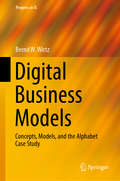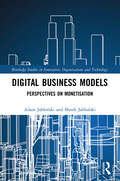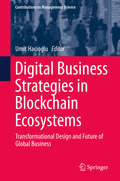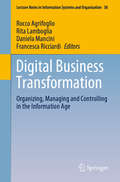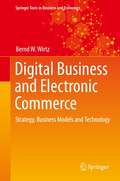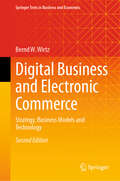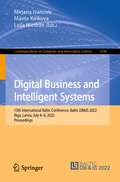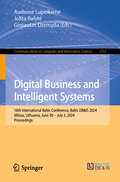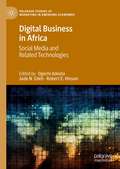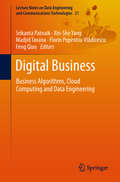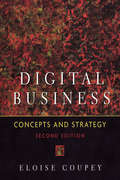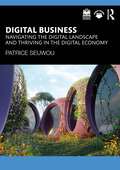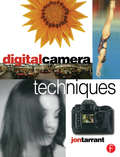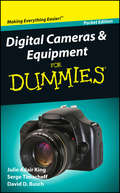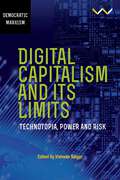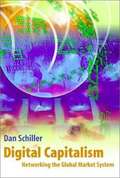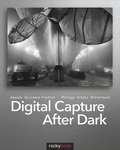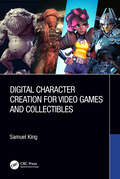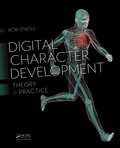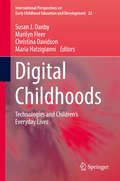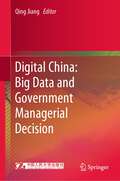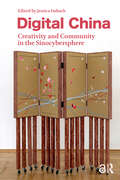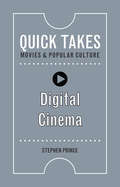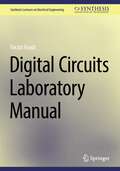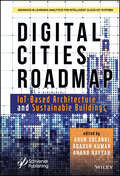- Table View
- List View
Digital Business Models: Concepts, Models, and the Alphabet Case Study (Progress in IS)
by Bernd W. WirtzThe spread of the Internet into all areas of business activities has put a particular focus on business models. The digitalization of business processes is the driver of changes in company strategies and management practices alike. This textbook provides a structured and conceptual approach, allowing students and other readers to understand the commonalities and specifics of the respective business models. The book begins with an overview of the business model concept in general by presenting the development of business models, analyzing definitions of business models and discussing the significance of the success of business model management. In turn, Chapter 2 offers insights into and explanations of the business model concept and provides the underlying approaches and ideas behind business models. Building on these foundations, Chapter 3 outlines the fundamental aspects of the digital economy. In the following chapters the book examines various core models in the business to consumer (B2C) context. The chapters follow a 4-C approach that divides the digital B2C businesses into models focusing on content, commerce, context and connection. Each chapter describes one of the four models and provides information on the respective business model types, the value chain, core assets and competencies as well as a case study. Based on the example of Google, Chapter 8 merges these approaches and describes the development of a hybrid digital business model. Chapter 9 is dedicated to business-to-business (B2B) digital business models. It shows how companies focus on business solutions such as online provision of sourcing, sales, supportive collaboration and broker services. Chapter 10 shares insight into the innovation aspect of digital business models, presenting structures and processes of digital business model innovation. The book is rounded out by a comprehensive case study on Google/Alphabet that combines all aspects of digital business models.Conceived as a textbook for students in advanced undergraduate courses, the book will also be useful for professionals and practitioners involved in business model innovation, and applied researchers.
Digital Business Models: Perspectives on Monetisation (Routledge Studies in Innovation, Organizations and Technology)
by Adam Jabłoński Marek JabłońskiBy presenting the conditions, methods and techniques of monetisation of business models in the digital economy, this book combines implementation of the theoretical aspects of monetisation with the presentation of practical business solutions in this field. The scope of the book includes the relationship between the monetisation and scalability degree of business models. The book describes the place and role of the digital business ecosystem in the process of digital transformation. It demonstrates ideological and functional conditions for the use of the concept of sharing to design innovative business models while also presenting a multi-dimensional approach to the use of Big Data and their monetisation in the context of business models. Digital Business Models shows the place and role of ecological and social factors in building digital business models that are part of the concept of the circular economy and presents the contemporary conditions of a sustainability concept that meets the ethical challenges of doing digital business. It demonstrates how important the social factors of business model design and the creation of social value are in modern business and demonstrates. The book explores the servitisation of digital business models using digital technologies and features case studies on the effective solutions of business models that use servitisation as a factor supporting the monetisation of business models. Written for scholars exploring the efficiency and effectiveness of business models related to contemporary concepts – Sharing Economy, Circular Economy, Network Economy, Big Data, so on – and those designing business models taking into account social aspects, it will also be of direct interest to entrepreneurship courses.
Digital Business Strategies in Blockchain Ecosystems: Transformational Design and Future of Global Business (Contributions to Management Science)
by Umit HaciogluThis book analyzes the effects of the latest technological advances in blockchain and artificial intelligence (AI) on business operations and strategies. Adopting an interdisciplinary approach, the contributions examine new developments that change the rules of traditional management. The chapters focus mainly on blockchain technologies and digital business in the "Industry 4.0" context, covering such topics as accounting, digitalization and use of AI in business operations and cybercrime. Intended for academics, blockchain experts, students and practitioners, the book helps business strategists design a path for future opportunities.
Digital Business Transformation: Organizing, Managing and Controlling in the Information Age (Lecture Notes in Information Systems and Organisation #38)
by Francesca Ricciardi Rocco Agrifoglio Daniela Mancini Rita LambogliaThe recent surge of interest in “digital transformation” is changing the business landscape and posing several challenges, both organizational and sectoral. This transformation involves the application of digital technology in all aspects of business, and enables organizations to create new products and services, and to find more efficient ways of doing business.Moreover, the digital transformation is happening within and across organizations of all types and in every industry, producing a disruptive innovation that can break down the barriers between people and organizations, and help create more adaptive processes. In the information age, it is imperative for organizations to develop IT-related capabilities that allow them to leverage the potential of digital technologies. Due to the pervasive effects of this transformation on processes, firms and industries, both scholars and practitioners are interested in better understanding the key mechanisms behind the emergence and evolution of the digital business transformation.This book presents a collection of research papers focusing on the relationships between technologies (e.g., digital platforms, AI, blockchain, etc.), processes (e.g., decision-making, co-creation, financial, compliance, etc.), and organizations (e.g., smart organizations, digital ecosystems, Industry 4.0, collaborative networked organizations, etc.), which have been categorized into three major areas: organizing, managing and controlling. It also provides critical insights into how the digital transformation is enhancing organizational processes and firms’ performance through an exploration and exploitation of internal resources, and through the establishment of external connections and linkages. The plurality of views offered makes this book particularly relevant for users, companies, scientists, and governments. The content of the book is based on a selection of the best papers (original double-blind peer-reviewed contributions) presented at the annual conference of the Italian chapter of the AIS, which was held in Naples, Italy in September 2019.
Digital Business and Electronic Commerce: Strategy, Business Models and Technology (Springer Texts in Business and Economics)
by Bernd W. WirtzThis textbook introduces readers to digital business from a management standpoint. It provides an overview of the foundations of digital business with basics, activities and success factors, and an analytical view on user behavior. Dedicated chapters on mobile and social media present fundamental aspects, discuss applications and address key success factors. The Internet of Things (IoT) is subsequently introduced in the context of big data, cloud computing and connecting technologies, with a focus on industry 4.0, smart business services, smart homes and digital consumer applications, as well as artificial intelligence. The book then turns to digital business models in the B2C (business-to-consumer) and B2B (business-to-business) sectors. Building on the business model concepts, the book addresses digital business strategy, discussing the strategic digital business environment and digital business value activity systems (dVASs), as well as strategy development in the context of digital business. Special chapters explore the implications of strategy for digital marketing and digital procurement. Lastly, the book discusses the fundamentals of digital business technologies and security, and provides an outline of digital business implementation. A comprehensive case study on Google/Alphabet, explaining Google's organizational history, its integrated business model and its market environment, rounds out the book.
Digital Business and Electronic Commerce: Strategy, Business Models and Technology (Springer Texts in Business and Economics)
by Bernd W. WirtzThis textbook introduces readers to digital business from a management standpoint. It provides an overview of the foundations of digital business with basics, activities and success factors, and an analytical view on user behavior. Dedicated chapters on mobile and social media present fundamental aspects, discuss applications and address key success factors. The Internet of Things (IoT) is subsequently introduced in the context of big data, cloud computing and connecting technologies, with a focus on industry 4.0 and the industrial metaverse. In addition, areas such as smart business services, smart homes and digital consumer applications as well as artificial intelligence, quantum computing and automation based on artificial intelligence will be analysed. The book then turns to digital business models in the B2C (business-to-consumer) and B2B (business-to-business) sectors.Building on the business model concepts, the book addresses digital business strategy, discussingthe strategic digital business environment and digital business value activity systems (dVASs), as well as strategy development in the context of digital business. Special chapters explore the implications of strategy for digital marketing and digital procurement. Lastly, the book discusses the fundamentals of digital business technologies and security, and provides an outline of digital business implementation. A comprehensive case study on Google/Alphabet, explaining Google's organizational history, its integrated business model and its market environment, rounds out the book.
Digital Business and Intelligent Systems: 15th International Baltic Conference, Baltic DB&IS 2022, Riga, Latvia, July 4–6, 2022, Proceedings (Communications in Computer and Information Science #1598)
by Laila Niedrite Mirjana Ivanovic Marite KirikovaThis book constitutes the refereed proceedings of the 15th International Baltic Conference on Digital Business and Intelligent Systems, Baltic DB&IS 2022, held in Riga, Latvia, in July 2022. The 16 revised full papers and 1 short paper presented were carefully reviewed and selected from 42 submissions. The papers are centered around topics like architectures and quality of information systems, artificial intelligence in information systems, data and knowledge engineering, enterprise and information systems engineering, security of information systems.
Digital Business and Intelligent Systems: 16th International Baltic Conference, Baltic DB&IS 2024, Vilnius, Lithuania, June 30 – July 3, 2024, Proceedings (Communications in Computer and Information Science #2157)
by Jolita Ralyté Gintautas Dzemyda Audronė LupeikienėThis book constitutes the refereed proceedings of the 16th International Baltic Conference on Digital Business and Intelligent Systems, Baltic DB&IS 2024, held in Vilnius, Lithuania, during June 30–July 3, 2024. The 13 full papers and 3 short papers presented here, were carefully reviewed and selected from 36 submissions, and focus on the various fields of Business digitalization and development of intelligent business systems. Abstracts from the keynote speeches from the conference are also included in these proceedings.
Digital Business in Africa: Social Media and Related Technologies (Palgrave Studies of Marketing in Emerging Economies)
by Ogechi Adeola Robert E. Hinson Jude N. EdehThis edited volume seeks to examine how enterprises in Africa can utilize digital technologies and innovations in creating value for their customers and clients in order to increase effectiveness and efficiency. Through social media, businesses are increasingly reaching and engaging their customers in several ways and so enterprises in Africa must harness the opportunities in the digital space if they want to remain competitive, earn profit, and meet their customers’ needs. Accordingly, this book looks at how digital technologies are helping shape the financial, educational, and advertising sectors in Africa. As digital technologies raise challenges, the chapters that follow will discuss ethical and social practical frameworks to effective digital business in Africa. This volume promises to fore both theoretical underpinnings, and practical implementations of digital technologies in the African business context.
Digital Business: Business Algorithms, Cloud Computing and Data Engineering (Lecture Notes on Data Engineering and Communications Technologies #21)
by Xin-She Yang Madjid Tavana Srikanta Patnaik Feng Qiao Florin Popentiu-VlădicescuThis edited book presents contributions from three different areas: cloud computing, digital mess and business algorithms on a single platform, i.e. Digital Business. The book is divided into four sections: (i) Digital Business Transformation, (ii) Cloud Computing, (iii) IOT & Mobility, and (iv) Information Management & Social Media, which are part of a holistic approach to information management and connecting the value chains of businesses to derive more throughput in the entire business ecosystem. Digital business is a niche area of computer science and business management, and its dimension is vast – it includes technologies such as cloud computing, Internet of Things, mobile platforms, big data applied in areas like ERP, data mining and business intelligence. Digital technologies have also challenged existing business models and will continue to do so. One of the key driving forces is the capacity of innovation and the commercialization of information and communication technologies.Providing insights into the new paradigm of digital business, the book is a valuable resource for research scholars, academics and professionals.
Digital Business: Concepts and strategies
by Eloise CoupeyAs businesses adapt to the realities of the digital world and build on the hard-won insights of the digital business pioneers, increasing importance is placed on the need to understand how traditional concepts of business strategy and implementation are influenced by the Internet, and to identify the novel aspects of business that are made possible by the Internet. That is why this book was written. How do you succeed in the digital business environment? How do you make the transition from offline to online? What aspects of your business will be affected, and how should you manage them? Digital Business: Concepts and Strategies will help you develop the skills necessary to understand and integrate Internet technology and characteristics into business activity for attaining strategic objectives.
Digital Business: Navigating the Digital Landscape and Thriving in the Digital Economy
by Patrice SeuwouThis comprehensive guide explores the fundamentals of digital business, from understanding digital business models to leveraging emerging technologies and trends.This work begins by examining the rise of digital business and the disruption it caused within traditional industries. Chapters then delve into key topics such as building a digital business strategy, designing a strong online presence, e-commerce, digital marketing, data analytics, cybersecurity and more. Written in a clear and accessible style, the author provides real-world examples to illustrate how successful companies have leveraged digital technologies to drive growth and achieve their business goals. Each chapter features case studies, learning objectives and key discussion questions to augment student learning.This new text is recommended reading for undergraduate and postgraduate students of Digital Business, Digital Marketing, and Business Analytics. It will also be valuable reading for reflective practitioners in the industry.This book is accompanied by online resources including PowerPoint slides, an instructor's manual, a test bank of questions, and worksheets for each chapter, providing instructors with the necessary tools to keep their courses up to date, engaging, and effective in preparing students for the ever-changing digital business landscape.
Digital Camera Techniques
by Jon TarrantThe best photographs start with proper attention behind the camera before you take them. Jon Tarrant shows you how to achieve this by fully explaining how digital cameras work so you too can achieve professional-looking results without having to resort to image manipulation on a computer. Jon explains all the basics of digital cameras: their anatomy; an outline of broad classes, indicated by price bands and features offered; a comparison with existing families of film cameras as a useful guide to newcomers. He also provides an invaluable buyer's guide pointing out features to look for on a digital camera before you make your purchase.Coverage includes detail on lenses, exposure basics, 'correct' exposure, using flash, the chip and the implications of this 'restriction', image quality and retaining this quality, as well as discussion of the difficulties of digital cameras and sections on specific types of photography with digital cameras. Complete coverage is ensured with information on printing, storage and filing, the Internet as a medium of images, picture software and digital enhancement, always keeping the emphasis on the fact that the most important consideration is how you take the photographs and the vision you had then and knowing when to stop tinkering with your image!This inspirational, full colour guide is what all digital camera owners have been waiting for. Jon Tarrant shows all keen digital photographers how to improve their photography and make the most of the latest technology.
Digital Cameras and Equipment For Dummies, Pocket Edition
by Julie Adair King Serge Timacheff David D. BuschHow to choose, use, equip, and maintain your digital camera Which digital camera best suits your needs? How many megapixels do you really need? How do you store and protect your photos? Which features areessential and which are expensive frills? Find the answers for buying, using, and caring for your digital camera in this little book! Open the book and find: How to choose between point-and-shoot and SLR Money-saving shopping pointers Insight on the best photo editing software Advice on memory cards and storage Camera maintenance and emergency care tips
Digital Capitalism and its Limits: Technotopia, Power and Risk
by Vishwas SatgarThe Fourth Industrial Revolution (4IR) has been described as the next big leap in digital capitalism. Digital technologies such as artificial intelligence, quantum computing, 3D printing and robotisation, we are led to believe, will bring more progress, growth and development while also helping us to resolve the deep and multiple crises the world is in. Billions are being invested in these technologies, accompanied by sharp geopolitical rivalries to secure an edge in the control over them. Volume 8 in the Democratic Marxism series invites readers to think more deeply and critically about digital capitalism and its limits. While most governments in the world, including South Africa, have accepted a techno-nationalist narrative and have deliberated on the risks for the planet and humanity, the volume interrogates the effects and consequences of advances in artificial intelligence and heightened technological innovation and industrialisation on employment, democracy and the climate. Viewing the grand social engineering of 4IR through a Marxist lens, the volume contributors engage critically with the class project of digital monopoly capitalism and its powerful totalitarian tendencies. They question the dangerous technotopian imaginary shaping this digital techno-shift, the implications of algorithmic data extractivism, the securitisation of already weak market democracies, the social consequences of digital learning, lack of regulation, and the power dynamics in the labour process. Anchored in techno-realism, the interdisciplinary perspective captured in this volume puts forward alternatives for democratisation and a just transition to protect human and non-human life.
Digital Capitalism: Networking the Global Market System
by Dan SchillerCyberspace not only exemplifies but spearheads the greater political economy of which it has become such a critical part. The networks that comprise cyberspace were originally created at the behest of government agencies, military contractors, and allied educational institutions. However, over the past generation or so, a growing number of these networks began to serve primarily corporate users. Under the sway of an expansionary market logic, the Internet began a political-economic transition toward what Dan Schiller calls "digital capitalism." Schiller traces these metamorphoses through three critically important and interlinked realms. Parts I and II deal with the overwhelmingly "neoliberal" or market-driven policies that influence and govern the telecommunications system and their empowerment of transnational corporations while at the same time exacerbating exisiting social inequalities. Part III shows how cyberspace offers uniquely supple instruments with which to cultivate and deepen consumerism on a transnational scale, especially among privileged groups. Finally, Part IV shows how digital capitalism has already overtaken education, placing it at the mercy of a proprietary market logic.
Digital Capture After Dark
by Amanda Quintenz-Fiedler Philipp Scholz RittermannThe pitfalls of photographing at night are many. Autofocus and built-in light meters generally fail at night. Long exposures tend to make noisy or blurry photographs. Cameras set to automatic generally trigger the built-in flash in low light conditions, which results in unsatisfying images. Lack of understanding and inappropriate techniques often ruin the dramatic potential of nighttime images. In Digital Capture After Dark you will learn to overcome these and other obstacles. You will go beyond the many "how-to's" of capturing digital images at night to the "why-to's" of long exposure photography; including the importance of how we think and see at night compared to during the day. Also discussed are hands-on image editing techniques that will help you prepare your images for output. Detailed descriptions cover color balancing, expanding dynamic range, controlling flare, dealing with noise, converting to black-and-white, toning, and much more.
Digital Character Creation for Video Games and Collectibles
by Samuel KingThis book covers the process of creating digital characters for video games as well as for 3D printing and collectibles. It looks at character asset creation for high-end AAA console games as well as asset creation for legacy devices and the ever-growing mobile gaming industry. Lastly, it covers creation of figurines for 3D printing and collectibles. Digital Character Creation for Video Games and Collectibles provides a step-by-step walkthrough of creating these assets at an industry level standard. It includes the necessary theory that you need to understand how to be an effective character artist, but primarily focuses on the practical skills needed for creating character assets in the modern games and collectibles industries. This book will be of great interest to all beginners and junior character artists currently working in the gaming or collectible industry and for those looking to enter these industries. There is also relevant content in the highly detailed examples for people currently working in the industry and looking to pick up a few new tips, tricks and knowledge.
Digital Character Development: Theory and Practice, Second Edition
by Rob O'NeillEvery animated film and video game production spends a large percentage of its resources and time on advancing the quality of the digital characters inhabiting the world being created. This book presents the theory and practice behind the creation of digital characters for film and games using software-agnostic descriptions that apply to any animation application. It provides insight from a real production environment and the requirements that such an environment imposes. With rich illustrations and visual code examples throughout, this book provides a comprehensive roadmap to character development for both professionals and students.
Digital Childhoods: Technologies And Children's Everyday Lives (International Perspectives on Early Childhood Education and Development #22)
by Marilyn Fleer Susan J. Danby Christina Davidson Maria HatzigianniThis book highlights the multiple ways that digital technologies are being used in everyday contexts at home and school, in communities, and across diverse activities, from play to web searching, to talking to family members who are far away. The book helps readers understand the diverse practices employed as children make connections with digital technologies in their everyday experiences. In addition, the book employs a framework that helps readers easily access major themes at a glance, and also showcases the diversity of ideas and theorisations that underpin the respective chapters. In this way, each chapter stands alone in making a specific contribution and, at the same time, makes explicit its connections to the broader themes of digital technologies in children’s everyday lives. The concept of digital childhood presented here goes beyond a sociological reading of the everyday lives of children and their families, and reflects the various contexts in which children engage, such as preschools and childcare centres.
Digital China: Big Data and Government Managerial Decision
by Qing JiangThis book is the first practical case study on the application of big data in China's government management scenarios, which is important for comprehensively presenting the achievements of China's e-government and digital construction as well as deeply understanding the implementation of big data strategy in China.The author of this book is one of the earliest practitioners engaged in the study of big data applications, and has personally experienced the development, major events, application cases, and industry changes of big data in China. Cases in this book are all actual projects carried out. The author of this book explains the development history of big data she has personally experienced, presenting in an easy-to-understand way the basic concept and characteristics of big data and practical interpretation, which provides important reference for the practical work of government and enterprise managers. The application ideas of big data in management innovation are proposed, and scenarios are described and discussed in terms of accelerating research on sharing big data in government affairs, breaking barriers, realizing data flow information sharing, creating one-stop services, improving the corresponding policy system for sharing big data in government affairs, building public information platform for e-government, and strengthening network and information infrastructure.Especially for the government personnel in departments, this book will give them a better understanding of the charm and value of big data, intuitively understand the utilization and analysis of big data, carry out effective government management and make correct decisions, so as to improve the data literacy of organizations and individuals, form scientific support for their own government's decision-making and management, thus promote the continued construction of digital government, digital China, and digital economy era based on the application of big data.
Digital China: Creativity and Community in the Sinocybersphere
by Jessica ImbachOver the past decade, digital technologies have profoundly reshaped the Chinese cultural landscape. With a focus on the creative agency of new media and online communities, this volume examines this development through the notion of the Sinocybersphere - the networked spaces across the globe that not only operate on the Chinese script, but also imaginatively negotiate the meanings of Chinese culture in the digital age. Instead of asking what makes the internet or new media “Chinese,” the chapters situate contemporary entanglements of cultural and digital practices within specific historical, social, and discursive contexts. Covering topics as diverse as live-streaming, AI poetry, online literature, poetry memes, cyberpunk fiction, virtual art exhibitions, cooking videos, censorship, and viral translations, the collection as a whole not only engages with a wide range of Chinese new media phenomena, but also demonstrates their relevance to our understanding of contemporary digital culture.
Digital Cinema: The Seduction Of Reality (Quick Takes: Movies and Popular Culture)
by Stephen PrinceDigital Cinema considers how new technologies have revolutionized the medium, while investigating the continuities that might remain from filmmaking’s analog era. In the process, it raises provocative questions about the status of realism in a pixel-generated digital medium whose scenes often defy the laws of physics. It also considers what these changes might bode for the future of cinema. How will digital works be preserved and shared? And will the emergence of virtual reality finally consign cinema to obsolescence? Stephen Prince offers a clear, concise account of how digital cinema both extends longstanding traditions of filmmaking and challenges some fundamental assumptions about film. It is essential reading for anyone interested in understanding how movies are shot, produced, distributed, and consumed in the twenty-first century.
Digital Circuits Laboratory Manual (Synthesis Lectures on Electrical Engineering)
by Farzin AsadiDigital systems are an important part of modern life. This book introduces the basic building blocks of digital systems and how these blocks can be used to design a digital system. It can be used as a laboratory manual for courses such as Digital Logic and Digital Electronics. All of the experiments in this book can be done in a simulation environment like: Proteus® or NI® MultiSim® or on the breadboard in a real laboratory environment.
Digital Cities Roadmap: IoT-Based Architecture and Sustainable Buildings (Advances in Learning Analytics for Intelligent Cloud-IoT Systems)
by Anand Nayyar Arun Solanki Adarsh KumarA good management strategy must be expected to mitigate the dangerous consequences of rapid urbanization that modern society, the economy, and the environment may face. Sustainable smart cities include established structures, infrastructures, communities, institutions, and individuals. On the other hand, this book also deals with energy consumption. Such energy consumption leads to a rapid depletion of energy resources, an increased need for building maintenance, an improvised comfortable lifestyle, and an increase in time spent on building construction. A sustainable building mainly explains the renewable sources used for construction, which helps the structure withstand atmospheric changes. Currently, all countries are looking for ecological materials, that is, renewable plant materials such as straw and clay bricks, wood from forests certified for sustainable management, recycled materials, and other non-toxic, reusable and renewable products. For sustainable and durable construction, energy efficiency is an urgent problem, and researchers are currently actively involved in this area. This book will provide an in-depth analysis of design technologies that lay a solid foundation for sustainable buildings. The book also highlights smart automation technologies that help save energy, as well as various performance indicators needed to make construction easier. The book aims to create a strong research community, to have a deep understanding and the latest knowledge in the field of energy and comfort, to offer solid ideas in the nearby future for sustainable and resilient buildings. These buildings will help the city grow as a smart city. The smart city has also focused on low energy consumption, renewable energy, and small carbon footprints. To find the optimal use of energy resources, researchers must study optimization methods.
